 |
Daugavpils Fortress
Daugavpils, Latvia
|
|
 |
Constructed: 1810-1878
Used by: Russia, Latvia, Germany
Conflict in which it participated:
Patriotic War of 1812,
Latvian War of Independence
Also known as: Dünaburg Fortress,
Dvina Fortress
|
Daugavpils is one of those eastern European cities that, as it has been galloped over by so many different regional powers, has been known by many names...so pay attention, because this might get even more confusing than usual. The process began in 1275, when the Livonian Order, a particularly energetic organization of Teutonic Knights, established Dünaburg Castle about 20 miles up the Daugava River from Daugavpils' present location. |
 |
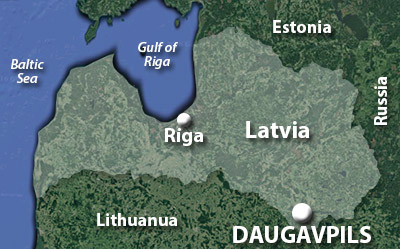 |
|
This castle remained, fat 'n' happy, until it was captured 'n' destroyed by Tsar of All the Russias Ivan the Terrible (1530-1584) in 1577. The Polish-Lithuanian Commonwealth, of which Daugavpils was by this time a part, built a new castle at the city's current location that same year.
The Russo-Swedish War (1656-1658) brought the merry and benevolent Russian bear back to the region in June of 1656. Our city was now known as Dynaberg, and the Russians, under the command of Tsar Alexi Mikhailovich (1629-1676), laid siege to the castle for about two weeks...then breached the castle's walls in a night attack and killed everyone inside.
|
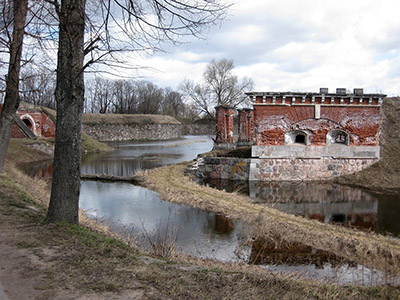 There's a lot of Daugavpils Fortress left to enjoy today, much of it in a fetchingly deteriorative state. There's a lot of Daugavpils Fortress left to enjoy today, much of it in a fetchingly deteriorative state. |
 |
Tsar Alexi officially changed the name of his new city to Borisoglebsk, which unfortunate title it retained for the next eleven years. With the peace of 1667, the city was returned to the Polish-Lithuanian Commonwealth, which immediately chipped "Borisoglebsk" off of everything and reinstated the name Dünaburg.
The Polish-Lithuanian Commonwealth was dissolved by 1795, after several partitions of its lands, which were happily gobbled up by its neighbors. Russia got Dünaburg in 1772, but fortunately did not insist on any ridiculous renamings this time.
What Russian Tsarina Catherine the Great (1729-1796) did insist upon for Dünaburg, however, was a starfort. |
|
|
Planning for what would become Daugavpils Fortress began immediately, but it took Napoleon (1769-1821) to light a fire of necessity beneath Tsar Alexander I (1777-1825). Alexander changed Russia's position as regarded the French four times during the Napoleonic Wars (1803-1815): Neutrality, opposition, alliance and back to opposition. It was in 1810, during a period of "alliance" with the French which was rapidly deteriorating, that Alexander directed that a fortification at Daugavpils be erected to act as a defensive base on Russia's western border. He knew Napoleon would be coming for Dünaburg at some point, alliance or no alliance.
|
10,000 workers were conscripted for the task of IMMEDIATELY causing a starfort to exist. The French did indeed come in 1812, as part of their ill-fated Russian invasion. 24,000 French troops descended upon what would have then been known as Dünaburg Fortress, which was most definitely in an unfinished state. The starfort of our current interest wasn't technically completed until 1878, so what was there to greet the French in 1812?
Whatever it was, it was enough. Manned by 3300 defenders with 200 cannon, Dünaburg Fortress fulfilled its intended role of defending itself from the French. Napoleon's Grand Armée would ultimately make it to Moscow, but 'twas a burning, evacuated Moscow.
|
 |
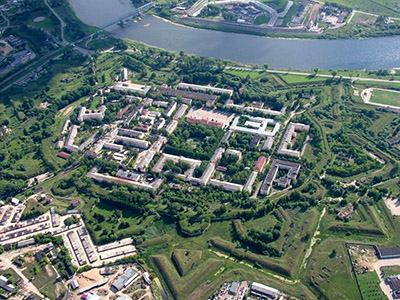 Daugavpils Fortress is really big. Did you notice how big it is? Big, I tell you. Daugavpils Fortress is really big. Did you notice how big it is? Big, I tell you. |
|
The French were forced to retreat into the Russian winter: Of the original 670,000 men Napoleon brought into Russia in June of 1812, only 27,000 men of the Grand Armée made it back to France. While it would be a stretch to suggest that Dünaburg Fortress was single-handedly responsible for Napoleon's defeat, I am hereby suggesting it anyway. Because starfort!
|
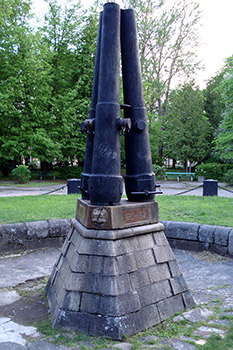 Daugavpils Fortress' Iron Fountain, made of 12-pounder cannon that heroically helped defend the heroic fort from the French, in an heroic fashion. Heroic. Daugavpils Fortress' Iron Fountain, made of 12-pounder cannon that heroically helped defend the heroic fort from the French, in an heroic fashion. Heroic. |
 |
In June of 1833 Dünaburg Fortress was visited by Tsar Nicholas I (1796-1855) and much of Russia's higher clergy: The fortress was officially consecrated at this time. Our starfort was on the route through which Russian nobility traveled from St. Petersburg, the Russian Empire's capital city from 1713 until 1918, to Europe...so Dünaburg Fortress would eventually be visited by all three Tsars Alexander, and both Nicholases.
Poles rebelled against their Russian overlords in January of 1863. While Dünaburg Fortress isn't anywhere near Poland, it is very close to the border of Lithuania, which had recently been closely allied with Poland...thus our Fortress was fully manned in the expectation of an imagined overwhelming Lithuanian attack, with 258 assorted cannon being shipped from fortifications in Tallinn, Estonia to bolster the fort's firepower. These additional Estonian guns must have cowed the bloodthirsty Lithuanians, as Dünaburg Fortress was not attacked.
The town and Fortress of Dünaburg got to go through another exhilarating name change in January of 1893, when Tsar Alexander III (1845-1894) proclaimed that, from this moment hence, Dünaburg shall be known as Dvinsk. Why was it necessary to further confuse everybody? Tsars don't have to give reasons for such decisions. The dudes with chisels got back to work obliterating the word Dünaburg from all surfaces. |
|
|
Dvinsk was placed under martial law in August of 1914, as the world went to war. Dvinsk Fortress (now heroically known as Warehouse Castle Dvinsk) spent some time as the headquarters of the Dvinsk Military District, but was otherwise unaffected by the First World War (1914-1918).
|
The power vacuum created by the Russian Revolution of 1917 and the end of the First World War allowed the nation of Latvia to declare independence on November 21, 1918. The newly-christened Red Army invaded Latvia just two weeks later, intent on retaining Latvia as part of Russia.
By the beginning of 1919, most of Latvia was under Russian control, but by the end of that year, Polish forces and the spunky Latvian Army had pushed the Red Army almost completely out of Latvia...except for Dvina! One of the Red Army's last strongholds in Latvia was none other than our very own Dvina Fortress! The Battle of Dvina (Also known as the Battle of Daugavpils, the Battle of Dynaburg, and the Battle of Whatever-That-City-Is-Called-These-Days) would be the final battle of the Latvian War of Independence. |
 |
 Daugavpils Fortress contains its own military town...which looks (to me) oddly similar to that within Fort Monroe in the United States! Thanks for the photography, Mr. Grunskis! Daugavpils Fortress contains its own military town...which looks (to me) oddly similar to that within Fort Monroe in the United States! Thanks for the photography, Mr. Grunskis! |
|
|
Though effective against the French in 1812, Dvinsk Fortress proved to be no match for the dreaded Poles. Attacking over the frozen Daugava River on January 5, 1920, the Polish 3rd Legionary Division stormed the fortress, while the 1st Infantry Division attacked from the north. The Red garrison fled from the fortress and surrendered to nearby Latvian forces.
|
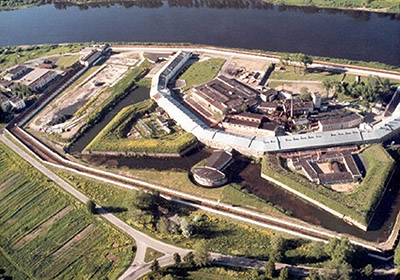 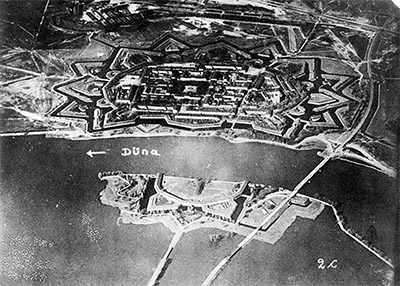 Across the Daugava River from the main fort is the Griva Bridgehead. At one point this pontoon bridge was assumedly one of the main entrances into Daugavpils Fortress, which demanded its own two dedicated bastions! The black & white image is an aerial photograph taken during the First World War: Note how the Griva Bridgehead is its own island! The Daugava River is a floody one. Across the Daugava River from the main fort is the Griva Bridgehead. At one point this pontoon bridge was assumedly one of the main entrances into Daugavpils Fortress, which demanded its own two dedicated bastions! The black & white image is an aerial photograph taken during the First World War: Note how the Griva Bridgehead is its own island! The Daugava River is a floody one. |
 |
Finally (though temporarily) free to unnecessarily rename their own cities, the victorious Latvians gave Dünaburg/Borisoglebsk/Dvinsk its final name, Daugavpils (literally "Daugava Castle") in 1920. Daugavpils Fortress was the home of the Latvian Zemgale Division until 1939, when Latvia was forced to accept a "mutual assistance" pact with the Soviet Union, which resulted in the Russians coming back in and taking over.
Followed in 1941 by the Nazis! If there's one thing we've learned about the Nazis in our studies for this site, it's that they seldom passed up an opportunity to make use of a cool starfort. Daugavpils Fortress was renamed Stalag 340, next to which local Jews were collected in a ghetto, before being marched off to be murdered in nearby forests. This least fortunate utilization of a starfort ever continued until 1944, when the marginally-better-to-live-under Soviets chased the Germans away for good.
And stayed for a while! Under the auspices of the Russian-dominated Latvian Soviet Socialist Republic, Daugavpils Fortress served as the Daugavpils Higher School of Military Aircraft Engineering from 1948 to 1993, bridging Latvia's most recent independence from Russia, which occurred in 1991.
Today, much of the historic buildings within Daugavpils Fortress are available for purchase. |
|
|
The Šafrans construction company owns much of what's inside the fortress today, and is trying to attract investors interested in restoring these buildings, and opening them for commercial activity. We are assured that recently, "the program of obtaining a residence permit for investors changed, but nothing terrible happened."
|
As a final note on Daugavpils Fortress, I have over the years read a few vague statements, from different sources, that Napoleon was afraid of starforts, and would go far out of his way to avoid having to attack them. This came up again in researching Daugavpils Fortress: Supposedly, the French defeat there in 1812 convinced him that it would be silly to attack St. Petersburg, where the lovely Peter and Paul Fortress guarded against a seaborne approach to the city...which may have been true to an extent, but not because of a starfort. Though the starfort was invented in Italy, the French were generally recognized as masters of the art of starfortery. |
 |
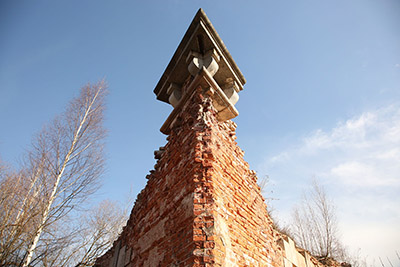
One of Daugavpils Fortress' pleasingly dilapidated bastions. I actually paid money for this image, because if I'd been there, this is the picture that I would've taken. Enjoy, Internet! |
|
|
Vauban (1633-1707), the "Father of the Starfort," was not only the man in charge of building starforts for French King Louis XIV (1638-1715), but also the military engineer in charge of advising how to defeat starforts. When the French army came up against a starfort manned by somebody else's army, in came Vauban, making the Generals get him coffee and putting his feet up on the furniture, to plan how to get around all of those interlocking defensive measures that make starforts such a delight for us to behold today. While Napoleon surely recognized the starfort as a tough nut to crack, he did not cower in their collective shadow. The Ciudadela de Pamplona, Ciudadela de Jaca and Fortress of Almeida are three big whopping starforts that Napoleon had no trouble capturing...and I could probably find plenty more if I weren't so lazy. Many thanks to Vadims Voronovs for suggesting Daugavpils Fortress!!
|
|
|
|
|
|
 |




